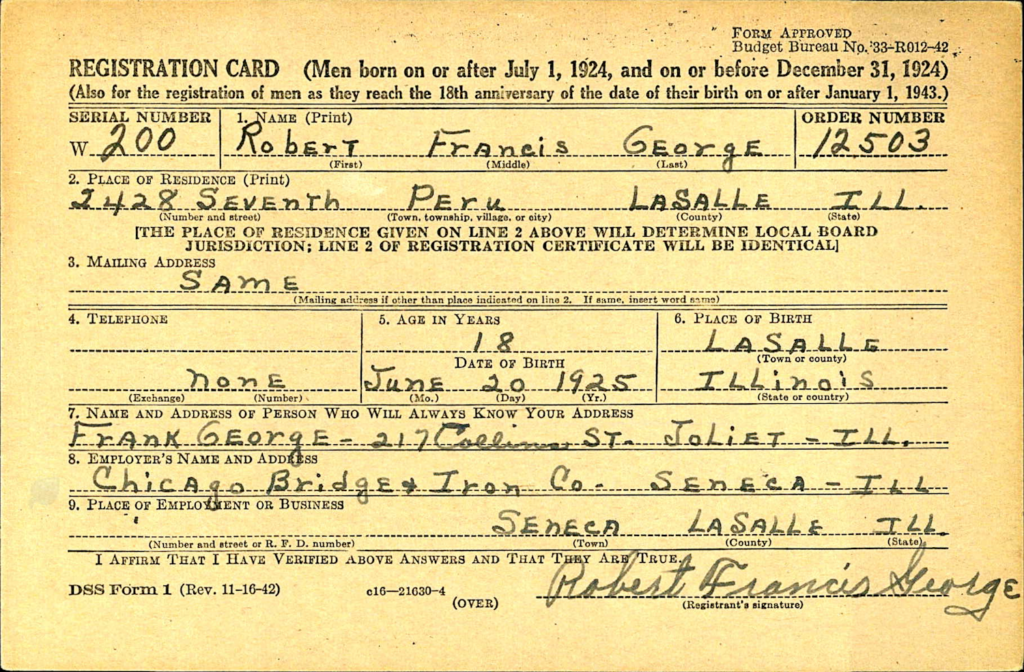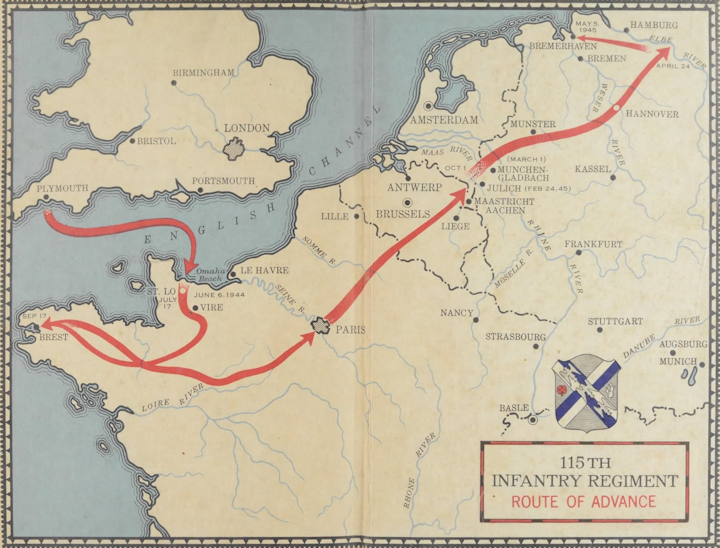Private Robert Francis George was born on 20 June 1925, in LaSalle, Illinois, into a family that knew both joy and sorrow. He was the second son of Frank George and Marie (Essl) George. His older brother, Francis, was stillborn the year before Robert’s birth. Robert’s early years were shaped by family hardships and the strength of those who surrounded him. His mother’s health had been frail since childhood, a consequence of surviving a severe smallpox epidemic that claimed her father when she was still a teenager.
When Robert was almost two years old, tragedy struck again. His mother went into premature labor and gave birth to a boy, William, at St. Mary’s Hospital. Just a day later, on 2 November 1927, Marie passed away at the age of 27 due to complications from the pregnancy. Baby William lived only five days, leaving Frank George a grieving widower with a toddler to raise. Marie’s death brought further upheaval to the family. They continued to live with Robert’s maternal grandmother, Theresa Essl, who likely provided support despite her advanced age. However, Theresa too passed away the following year on her 71st birthday, 5 October 1928.
By the time of the 1930 census, Frank and Robert were living with Robert’s paternal grandparents, David and Mary George, in Peru, Illinois. Robert’s father, Frank, worked as a custodian at the Knights of Columbus Club Rooms, while the grandparents provided a stable, if modest, home for young Robert. His grandfather, a former carpenter, could no longer work, and the family made ends meet with what resources they had.
Robert’s teenage years saw him attending high school and living with his grandparents at 2428 Seventh street in Peru, Illinois. By 1943, Robert was a hardworking young man employed by the Chicago Bridge & Iron Company in Seneca, Illinois. On 21 June 1943, the day after his 18th birthday, Robert registered for the draft. At 5 feet 7 ½ inches tall and weighing 160 pounds, he was described as having gray eyes and brown hair. During this time period, Robert’s father, Frank, had relocated to Joliet for work at the Sanderson & Porter Elwood Ordnance Plant, leaving Robert to care for his elderly grandparents.

Robert’s service to his country began when he enlisted in the Army on 4 September 1943. By 25 September, he was called into active duty. Initially he trained at Camp Wolters, Texas, where he briefly fell ill and spent time in quarantine. In April 1944, he was sent to Maryland to prepare for overseas deployment and eventually assigned to Company L of the 115th Infantry Regiment, 29th Infantry Division. This division, nicknamed “The Blue and Gray,” was destined for critical operations in the European Theater of World War II.

Private Robert George’s ultimate sacrifice came during the Brest Campaign in France. After the D-Day landings in June 1944, the Allies sought to capture the vital port city of Brest. By late August, Robert’s regiment faced fierce resistance from well-entrenched German forces. On 27 August 1944, as the 115th Infantry Regiment pushed forward amidst intense combat, Private George was killed in action. His bravery and dedication in one of the war’s most pivotal campaigns were emblematic of the sacrifices made by so many in pursuit of liberation.
Robert was laid to rest on 31 August 1944, in a temporary military cemetery. After the war, on 25 February 1949, his remains were moved to a permanent grave site in the Brittany American Cemetery in St. James, France, along with thousands of his fellow servicemen. The Army returned his personal belongings to his father, Frank, including 1,105 francs, a banknote worth 5 francs, six English coins, a key, a locket, identification cards, a birth certificate, and four cherished photographs.
PVT Robert F. George was eligible to receive posthumously the following: the Purple Heart, World War II Victory Medal, European-African-Middle Eastern Campaign Medal, and American Campaign Medal.
Robert’s service was not the first act of military valor in his family. His maternal uncle, Joseph George Essl, served in World War I as a cook with the Evacuation Ambulance Company No. 68 in the 6th Army Corps. Like Robert, Joseph’s wartime experiences had taken him to France decades earlier.
Private Robert Francis George’s story is one of resilience, duty, and sacrifice. From his humble beginnings in Illinois to the battlefields of France, he exemplified the courage of the Greatest Generation. Today, his memory endures in the soil of Brittany and the hearts of those who honor the fallen of World War II.
You can also access this story at the following sites:
Fold3 Memorial: https://www.fold3.com/memorial/664285791/george-robert-f/stories
- Sources:
- 1930 US Census, David George, Ancestry.
- 1940 US Census, David George, Ancestry.
- “Three New Cases of Small-pox in LaSalle,” The Bureau County Tribune, 22 March 1912, Newspapers.com.
- “U.S., Army Transport Service Arriving and Departing Passenger Lists, 1910-1939,” Incoming, Santa Elena, August 1919, No. 21 Joseph G. Essl, Ancestry.
- “U.S., World War II Draft Cards Young Men, 1940-1947,” Robert Francis George, Ancestry.
- “U.S., World War II Draft Cards Young Men, 1940-1947,” Frank Edward George, Ancestry.
- “U.S., Headstone and Interment Records for U.S., Military Cemeteries on Foreign Soil, 1942-1949,” Robert F. George, Ancestry.
- “Illinois, County Marriages, 1810-1940,” Frank George and Mary Essl, 1901, FamilySearch.
- “Texas, U.S., Death Certificates, 1903-1982,” Frank Edward George, Ancestry.
- “Illinois Deaths and Stillbirths, 1916-1947,” Francis George, Certificate of Stillbirth, 895, 1924, FamilySearch.
- “Illinois Deaths and Stillbirths, 1916-1947,” William George, Death Certificate 18543, 1927, FamilySearch.
- “Illinois Deaths and Stillbirths, 1916-1947,” Marie George, Death Certificate 18542, 1927, FamilySearch.
- https://www.findagrave.com/memorial/71382996/john-essl
- “Illinois, U.S., Deaths and Stillbirths Index, 1916-1947, Tressa Essl, Ancestry.
- U.S. Army, Letter of Induction, 1639th Service Unit, Chicago, Illinois, 4 September 1943.
- Company Morning Report, 14 January 1944, National Archives.
- Company Morning Report, 17 January 1944, National Archives.
- “Unit History – US, 115th Infantry Regiment, 1944-1945,” Fold3.
- https://www.findagrave.com/memorial/148983775/robert-francis-george